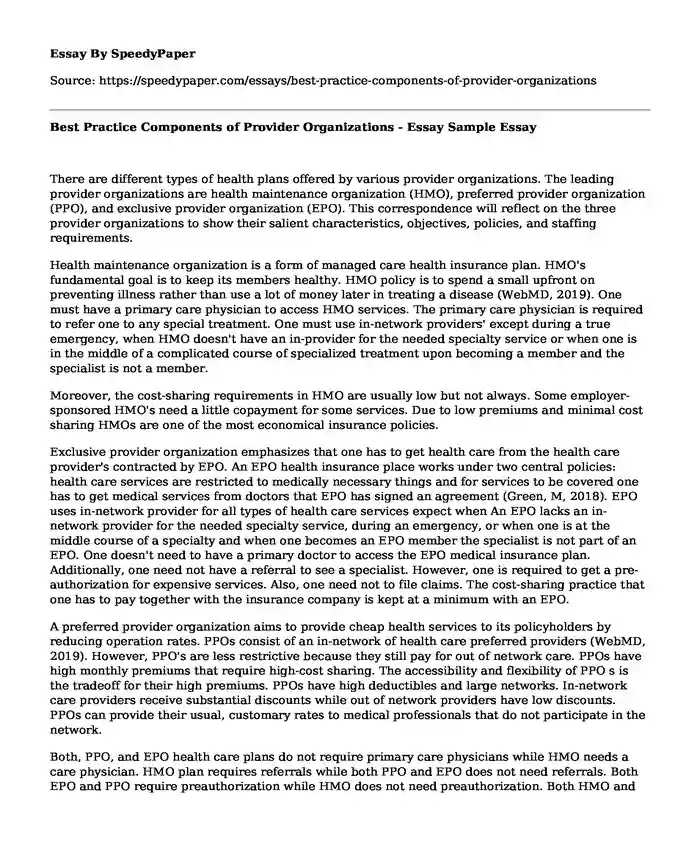
| Type of paper: | Course work |
| Categories: | Healthcare Business management Human services |
| Pages: | 3 |
| Wordcount: | 627 words |
There are different types of health plans offered by various provider organizations. The leading provider organizations are health maintenance organization (HMO), preferred provider organization (PPO), and exclusive provider organization (EPO). This correspondence will reflect on the three provider organizations to show their salient characteristics, objectives, policies, and staffing requirements.
Health maintenance organization is a form of managed care health insurance plan. HMO's fundamental goal is to keep its members healthy. HMO policy is to spend a small upfront on preventing illness rather than use a lot of money later in treating a disease (WebMD, 2019). One must have a primary care physician to access HMO services. The primary care physician is required to refer one to any special treatment. One must use in-network providers' except during a true emergency, when HMO doesn't have an in-provider for the needed specialty service or when one is in the middle of a complicated course of specialized treatment upon becoming a member and the specialist is not a member.
Moreover, the cost-sharing requirements in HMO are usually low but not always. Some employer-sponsored HMO's need a little copayment for some services. Due to low premiums and minimal cost sharing HMOs are one of the most economical insurance policies.
Exclusive provider organization emphasizes that one has to get health care from the health care provider's contracted by EPO. An EPO health insurance place works under two central policies: health care services are restricted to medically necessary things and for services to be covered one has to get medical services from doctors that EPO has signed an agreement (Green, M, 2018). EPO uses in-network provider for all types of health care services expect when An EPO lacks an in-network provider for the needed specialty service, during an emergency, or when one is at the middle course of a specialty and when one becomes an EPO member the specialist is not part of an EPO. One doesn't need to have a primary doctor to access the EPO medical insurance plan. Additionally, one need not have a referral to see a specialist. However, one is required to get a pre-authorization for expensive services. Also, one need not to file claims. The cost-sharing practice that one has to pay together with the insurance company is kept at a minimum with an EPO.
A preferred provider organization aims to provide cheap health services to its policyholders by reducing operation rates. PPOs consist of an in-network of health care preferred providers (WebMD, 2019). However, PPO's are less restrictive because they still pay for out of network care. PPOs have high monthly premiums that require high-cost sharing. The accessibility and flexibility of PPO s is the tradeoff for their high premiums. PPOs have high deductibles and large networks. In-network care providers receive substantial discounts while out of network providers have low discounts. PPOs can provide their usual, customary rates to medical professionals that do not participate in the network.
Both, PPO, and EPO health care plans do not require primary care physicians while HMO needs a care physician. HMO plan requires referrals while both PPO and EPO does not need referrals. Both EPO and PPO require preauthorization while HMO does not need preauthorization. Both HMO and EPO do not pay for out-of-network care while PPO pays for out-of-network care. The cost-sharing for HMO and EPO is typically lower for in-the-network care. On the other hand, the cost of sharing for PPO is relatively higher, especially for out-of-network care. It is critical to consider the benefits of each health insurance plan to make the right choice before subscribing into one.
References
Green, M. A. (2018). Understanding health insurance: A guide to billing and reimbursement. Cengage Learning.
WebMD (2019) Types of Health Plans: How They Compare. Retrieved 20 March 2019, from https://www.webmd.com/health-insurance/types-of-health-insurance-plans#3-6
Cite this page
Best Practice Components of Provider Organizations - Essay Sample. (2022, Dec 15). Retrieved from https://speedypaper.com/essays/best-practice-components-of-provider-organizations
Request Removal
If you are the original author of this essay and no longer wish to have it published on the SpeedyPaper website, please click below to request its removal:
- Art Essay Example: Cultural and Political Contexts of Asian-American Plays
- Free Essay on Community Health Nursing
- Activism in Disability Sports, Free Essay
- Classification or Division Paper Sample: Political Parties
- Free Essay with the Patient's Evaluation Statement
- Essay Sample Dedicated to the Hospitality Industry Labor Shortage
- Free Essay Example - The Sad Stories Behind The LeftOvers by Erin Whitney
Popular categories




